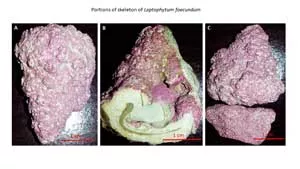
Under the Sea: Study reveals secret building blocks of northern algae
New research from U of T ‘s Mississauga and Scarborough campuses reveals fascinating secrets about the complex structure of a marine organism found around the globe. The data provides important new insights about a molecular mineralization process creates the unique structure of a marine plant.
Coralline algae is found around the globe where it grows in rock-like clusters on the ocean floor in both warm and cold waters, and often forms the structural base for coral reefs. The growth patterns of coralline algae can provide important information about past climate events and how aquatic organisms are reacting to new conditions caused by global climate change.

Chitin (pronounced kite-in) is naturally occurring polymer found in the makeup of coralline algae, as well as crustaceans, insects, fungi and nematode eggs. The polymer is strong, flexible and translucent, and its fibre-like form is used in environmental applications, such as improving water quality in aquaculture farms and aquariums, and biomedical applications such as wound dressing and stem cell therapies. In coralline algae, chitin hardens or calcifies the cell walls of the marine plant, creating the rock-hard skeleton of the algae.
The researchers developed a new tool to analyze the algae, building on a previous study by Rahman and collaborator Professor Jochen Halfar of UTM’s Department of Chemical & Physical Sciences. “Previously, it was thought that biopolymers like chitin had no role in the calcification process,” Rahman says. Their results revealed that chitin plays an important role by enabling the formation of magnesium calcite, an important building block in the hard skeleton of Leptophytum foecundum. “We have shown, for the first time, that chitin takes a key role in the process of mineral crystallization in marine organisms.”
Rahman notes that chitin is not found in other calcifying marine organisms, such as coral, but adds that further investigation may reveal the polymer in other varieties of coralline algae. The polymer also appears to provide protection from the impacts of climate change. “Chitin contains polysaccharides, which increases the resistance of calcifiers, like coralline algae, to negative effects of ocean acidification,” Rahman says.
“Our findings deliver new information about the marine ecosystem and our understanding of marine environmental changes,” he says. “The results could influence our thinking about the future response of coralline algae to global climate change.”
The study was published in the September 2019 issue of Nature. Contributors included Rahman, Halfar, Associate Professor Maria Dittrich and post-doctoral student Carlos Paulo, of UTSC’s Department of Physical & Environmental Sciences, Professor Walter Adey of the Smithsonian Institution, Museum of Natural History and Merinda Nash of Australian National University. The study was supported by funding from the Natural Sciences and Engineering Research Council of Canada, a Canadian Foundation for Climate and Atmospheric Sciences Grant, the Canadian Foundation for Innovation and the Ontario Research Fund of the Minister of Research and Innovation.
